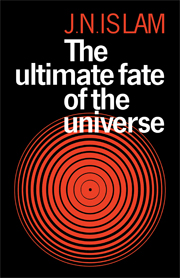Book contents
- Frontmatter
- Contents
- Preface
- Dedication
- Note on some conventions
- 1 Introduction
- 2 Our Galaxy
- 3 The large-scale structure of the universe
- 4 Elementary particles – a preliminary look
- 5 Is the universe open or closed?
- 6 Three ways for a star to die
- 7 Black holes and quasars
- 8 Galactic and supergalactic black holes
- 9 A black hole is not forever
- 10 Slow and subtle changes
- 11 Future of life and civilization
- 12 A collapsing universe
- 13 The steady state theory
- 14 The stability of the proton
- 15 Epilogue
- Glossary
- Selected bibliography
- Index
7 - Black holes and quasars
Published online by Cambridge University Press: 06 July 2010
- Frontmatter
- Contents
- Preface
- Dedication
- Note on some conventions
- 1 Introduction
- 2 Our Galaxy
- 3 The large-scale structure of the universe
- 4 Elementary particles – a preliminary look
- 5 Is the universe open or closed?
- 6 Three ways for a star to die
- 7 Black holes and quasars
- 8 Galactic and supergalactic black holes
- 9 A black hole is not forever
- 10 Slow and subtle changes
- 11 Future of life and civilization
- 12 A collapsing universe
- 13 The steady state theory
- 14 The stability of the proton
- 15 Epilogue
- Glossary
- Selected bibliography
- Index
Summary
As mentioned in the last chapter, when the mass of the star is greater than about three times the mass of the Sun, even the neutron Fermi pressure and other outward forces exerted by neutrons are not sufficient to withstand the force of gravity. There are no known forces in nature that can balance the force of gravity under these circumstances, and the star collapses and collapses until it reaches a very small volume with very high density. The precise nature of the final form that matter takes in this case is not known. What is indicated by Einstein's theory of gravitation is that when all the matter in the star goes within a certain small volume, no further communication is possible with the matter inside this volume, since any rays of light (which are the fastest possible signals) leaving it are pulled back towards the central region by the strength of gravity. The star then becomes a ‘black hole’. It is called ‘black’ because no radiation of any kind comes from within it. If the star has no rotation initially, the black hole quickly settles down to a spherical shape, the radius of the hole (from within which nothing can come out) being dependent on the total mass. For a mass M, the radius of the black hole, known as the Schwarzschild radius (after the German astronomer Karl Schwarzschild (1873–1916), who first found the solution of Einstein's equations in 1916 corresponding to a black hole) is 2GM/c2, where G is the Newtonian gravitational constant and c is the velocity of light.
- Type
- Chapter
- Information
- The Ultimate Fate of the Universe , pp. 73 - 81Publisher: Cambridge University PressPrint publication year: 1983



